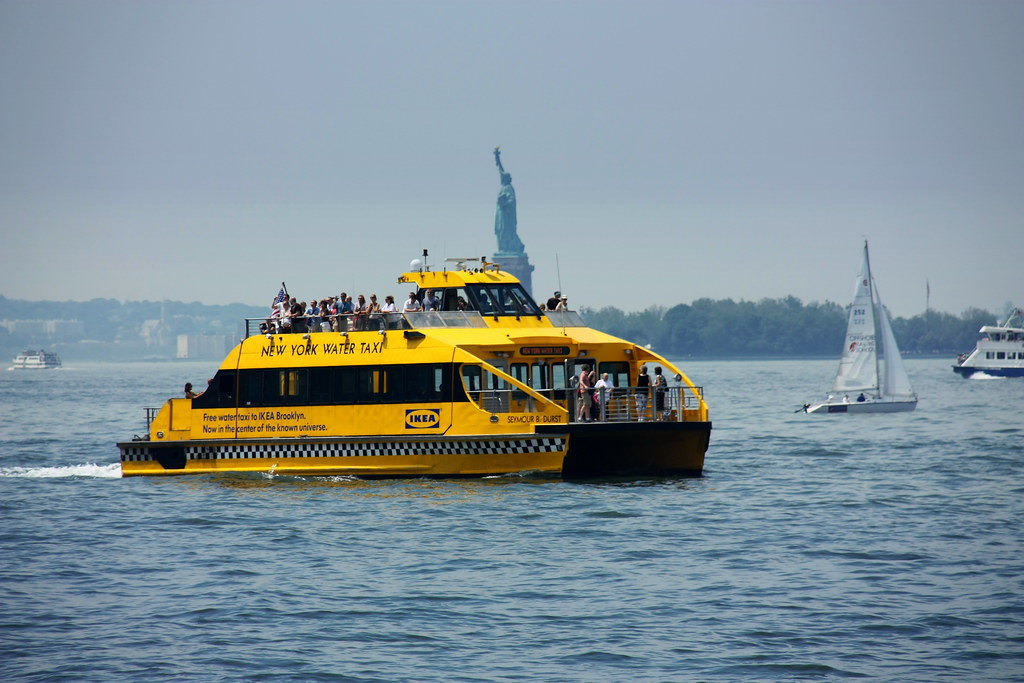A New York Water Taxi en route to Battery Park. (Photo via flickr user Tomas Fano)
For a city whose central business area is an island, New York City is surprisingly cut off from its waterways. With a road network ringing the island, numerous bridges and tunnels connecting Manhattan to the outside world and an extensive subway system that makes interborough travel an afterthought, the city can feel like just another landlocked metropolitan urban area.
Last week, though, I challenged that paradigm en route to a Yankee game. After more than two and a half decades of taking the 4, the D or the B (and once the C) to Yankee Stadium, my sister and I headed down to Pier 11 on Wednesday night, and at 5:30, we boarded the game-day special water taxi. The boat leaves 90 minutes before game time and drops its 150 passengers off on the far side of the new Metro-North stop at 153rd St. From there, it is about a ten-minute walk through a parking lot, over a train station and past the old stadium to the new ballpark.
As a means of travel to the stadium, the water taxi is more gimmick than practical mode of transit. Our door-to-door trip from Wall St. took over an hour while the 4 train takes approximately 35 minutes to make the same trip and leaves you closer to the stadium than the boat does. Yet, as we traveled, I marveled at the route. We motored past parts of the city most New Yorkers never see from the water, and my sister and discussed just how far some of those East Side dwellers are from the nearest subway stop. With a ferry stop only at 34th St. along the East Side, those who live far east either walk, take the bus or drive.
But what of the waterways? Ferry service in New York is never taken seriously, but a Times article published yesterday suggests that may change. Currently, approximately 100,000 people per day take ferries in New York, and according to Ariel Kaminer, most of those who aren’t taking the Staten Island ferry travel between New Jersey and Lower Manhattan. Some use the Ikea shuttle, and the once-a-day shuttle to and from the Rockaways has its followers.
Kaminer reports though that the city is looking to expand its use of the water ways. She writes:
Three public entities have been considering it from different angles. The Economic Development Corporation is soon to release its “Comprehensive Citywide Ferry Study.” The Department of City Planning is interested in how ferries could revitalize the waterfront. And the Office of Emergency Management is looking around for mass-evacuation plans. (In a crisis, you wouldn’t want to be left hailing a taxicab.) Put all that together, and there’s a chance that a decade from now, ferries could be mentioned along with buses and subways as main-course options on New Yorkers’ transportation menu…
Ferries are a growth opportunity. To add new routes, you don’t need to dig a tunnel or lay a track. You don’t need to reroute traffic, build bridges or add lanes. And in many parts of New York, unlike almost every other city, you wouldn’t need to build big parking lots where riders could leave their cars. What cars?
What you need is a viable pier and a boat. You need a convenient way to get from water’s edge to people’s ultimate destinations. And you need someone to be in charge of it all…
It’s hard to imagine ferry service expanding very far unless it becomes a public initiative, an integrated system with coordinated schedules and MetroCard access. But who would lead such an initiative? The Metropolitan Transportation Authority? The Port Authority of New York and New Jersey? The Department of Transportation? No one seems to know.
Whatever value these public agencies ultimately assign to reducing car traffic, easing interborough transit, supporting waterfront development or other such civic goals, New Yorkers have a personal reason to care. Ferries are fun. They tend to cost a few dollars more than other forms of mass transit, but you can think of the difference as an inexpensive form of mental health care.
In a sense, Kaminer treats ferries like a gimmick. They’re fun, she says, because to landlocked New Yorkers, they are. But ferries could do a lot for the city’s transit pathways as long as planners recognize something about ferries: They aren’t very fast, and they should be used to connect areas of the city that aren’t near or accessible to other transit options.
Because New York City opted to ring its waterfronts with roads, the bulk of development has occurred near the middle of the island. While people do live along the waterfront, far more people work, live and play in the center of the island, and for millions, ferries are inconvenient, impractical and slow. But if the city can figure out a way to run cost-neutral or even profitable ferry service from areas that don’t enjoy easy access to subways or regular bus routes, the only thing in the way, as Kaminer notes, would be a lack of a pier.
For most, ferries won’t become a way of travel. We live far from the shorelines and work far from the shorelines. Plus, as my meandering trip up the East River last week demonstrated, ferry travel can take twice as long as a subway covering the same ground can. Yet, it makes sense to invest in the waterways. If even enough people for a few boat rides a day find the taxis cheaper and more convenient than their current commutes, the ferries will have paid off.

